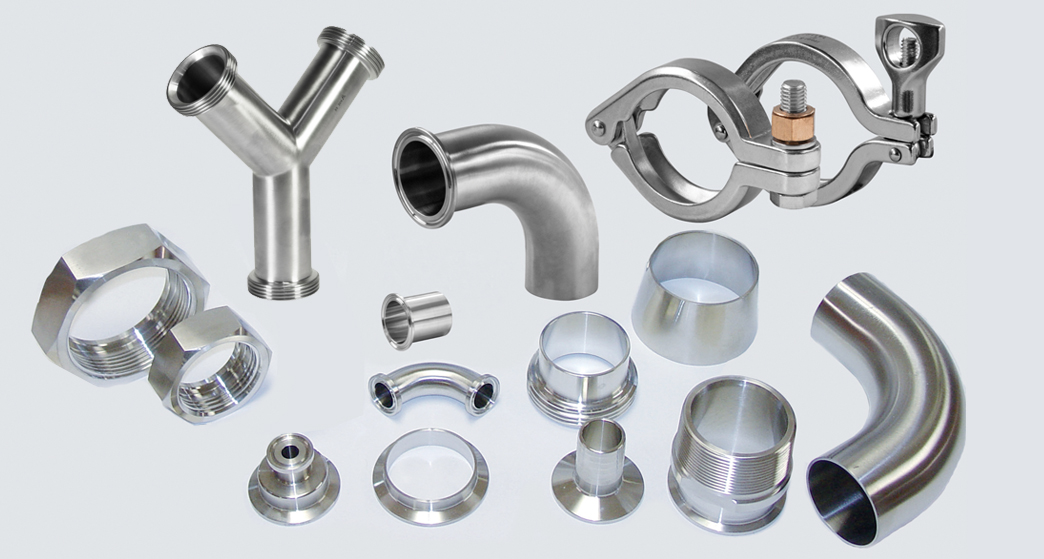In food, beverage, and pharmaceutical applications, sanitary fittings refer to specialized components designed to maintain hygiene and prevent contamination. These fittings ensure that systems used for transporting liquids, gases, or powders meet the strict health and safety standards common in the processing of foods, beverages, and pharmaceuticals.
Food and Beverage: Sanitary fittings used in the food and beverage sector serve diverse end markets, including brewing, dairy, confectionery, wine-making, and carbonated beverage production. Each application has distinct requirements, such as preventing bacterial growth in milk pipelines or managing high carbonation pressures in soda production. The importance of using 3-A certified stainless steel sanitary products helps ensure the necessary safety, sanitary, and contamination requirements are met. The standards also ensure that product contact surfaces can be easily cleaned and inspected.
Pharmaceuticals: Sanitary fittings used in the pharmaceutical industry serve as crucial connections between equipment to transfer ingredients and finished products. Pharmaceutical-grade sanitary fittings, typically referred to as BPE fittings, cater to biopharmaceuticals, vaccines, and sterile cosmetics production. These fittings often require an ultra-smooth finish, ensuring sterility and easy cleaning. Additional attributes, such as ASME BPE-compliant material traceability, documentation, and capping and bagging requirements, play a vital role in maintaining product purity.
Other Applications: Sanitary fittings are also vital in water treatment, liquid cooling for data centers, animal foods, and personal care product applications. Each market presents unique challenges—like maintaining sterility in cosmetics or preventing chemical reactions in aggressive environments—that sanitary fittings are specifically designed to address.
Key Features:
- Materials: Sanitary fittings are primarily made of stainless steel, with grades 304 and 316 being the most common due to their resistance to corrosion, durability, and smooth surfaces that facilitate cleaning. Grade 316 is preferred for harsher environments due to its added molybdenum, providing better protection against chlorides.
- Design: Smooth, crevice-free surfaces that minimize the risk of bacterial growth and make cleaning easier. Surface finishing plays a key role in the functionality of sanitary fittings. Roughness average (Ra), measured in microinches or microns, quantifies the surface smoothness. A lower Ra ensures fewer crevices for bacteria to harbor, facilitating effective cleaning. For instance, pharmaceutical fittings often require Ra ≤ 20 µin to meet stringent sterility standards.
- Connection Types: These often feature clamp, weld, or threaded connections that ensure secure and hygienic connections While balancing cleanability. For example, clamp connections allow systems to be easily dismantled for thorough cleaning between batches.
- Regulatory Compliance: Must meet standards set by organizations like the FDA, EHEDG, 3A, or ASME BPE, ensuring they are safe for use in food and pharmaceutical processes.
Attributes like pressure ratings and temperature tolerance become critical in high-demand applications. Sanitary fittings must endure the extreme heat of pasteurization or the pressures of carbonated beverage lines. Furthermore, material traceability ensures compliance with regulatory requirements, offering food and pharmaceutical production assurance.
Sanitary fittings play a vital role in maintaining the integrity and safety of products across several industries. Steel & O’Brien supplies a full line of high-quality 304 and 316 stainless sanitary and BPE fittings. Choosing the right sanitary fittings requires understanding application-specific needs like Ra standards, pressure tolerances, and material compliance. Contact us today at sales@steelobrien.com to learn how our expertise in stainless steel flow components and custom fabrication can be of service.

